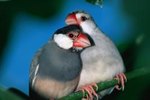
Male and female Quaker parrots have no visual differences. In order to accurately discover their gender, you should get DNA testing done through your veterinarian's office. Do not be fooled by the common misconception that you can tell the difference between males and females using color or anatomy markers to sex your parrot.
Misconceptions about Sexing Quaker Parrots
Some pet owners are told, and mistakenly believe, that you can tell the gender of your Quaker parrot by feeling the width of the hip bones. Females naturally have wider-set hip bones that allow for the accommodation of eggs, while males are more narrow. While males are generally not as wide as their female counterparts, sometimes their hips widen as they age, so this is not an accurate method in sexing your parrot.
No Dimorphic Traits
Quaker parrots are one of the uncommon species that have no dimorphic traits, or external visual traits that allow us humans to tell the males and females apart. The colors, sizes, body language and every other aspect of male and female Quaker parrots are completely identical. This makes it impossible for even the most astute pet owner to distinguish a male from a female.
Gender Specific Traits and Characteristics
A great example of how a parrot's actions might be misinterpreted would be the mating dance that is done by male Quaker parrots. If a female is nearby, a male will bob his head as he "dances" across his cage. If no female is present to mate with, a male might be observed using the same body language with his owner, but this cannot be used as an accurate means of telling gender because this could also be a sign of wanting attention. This behavior has also been observed in female Quaker parrots who have been raised alone.
References
Photo Credits
-
Tom Brakefield/Stockbyte/Getty Images
Writer Bio
Based in Lexington, Ky., Christina Root has worked as a blogger, writer and freelance consultant since 2009. As a mother, animal lover, natural alternative medicine enthusiast and a student of all things, she loves learning and sharing with others.



